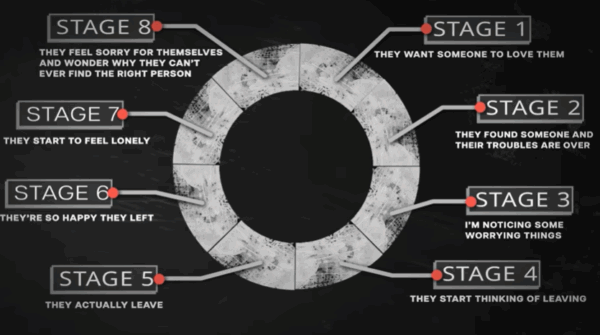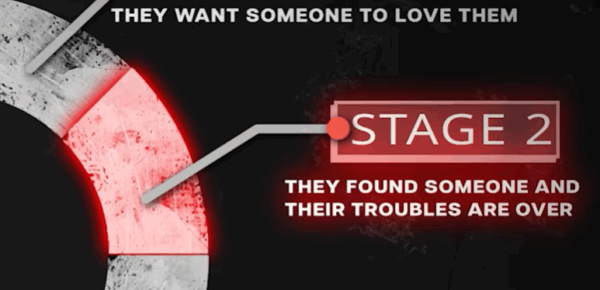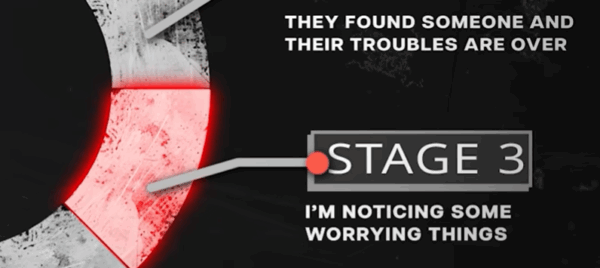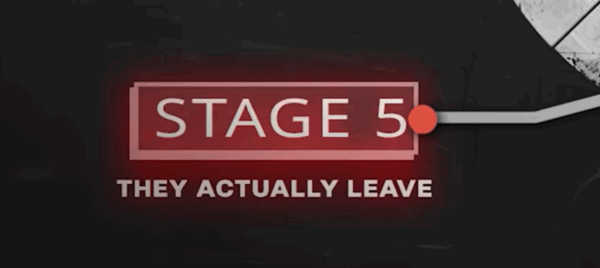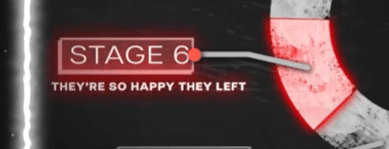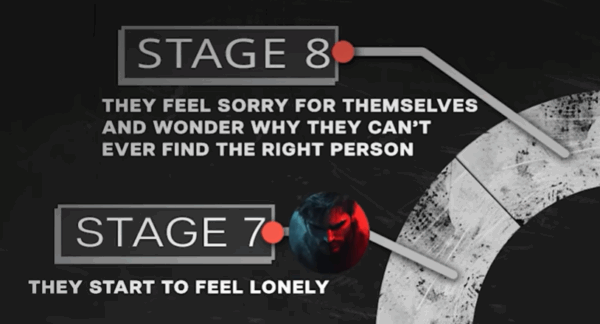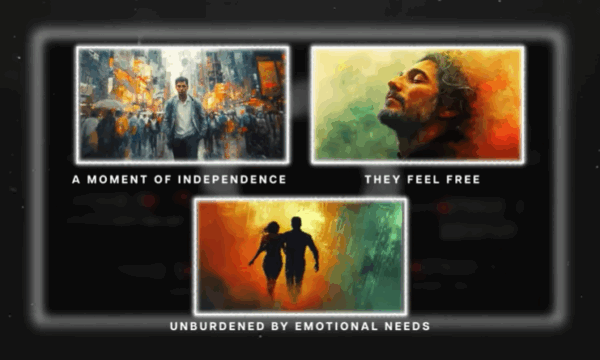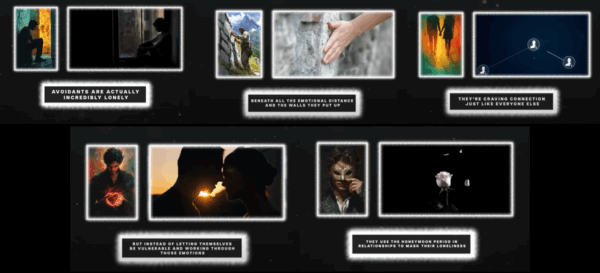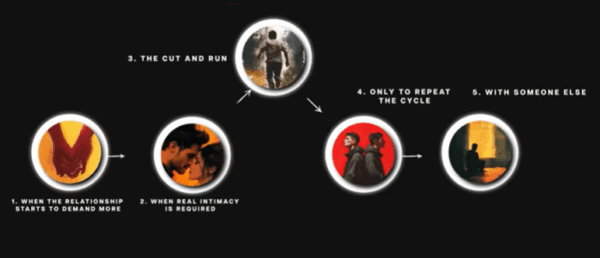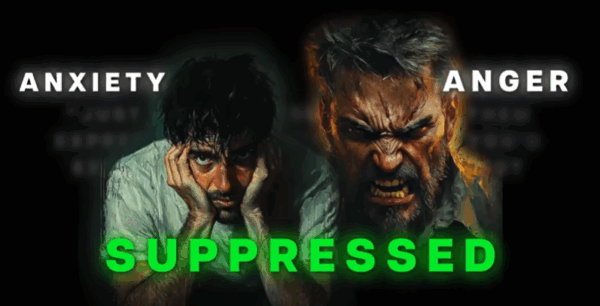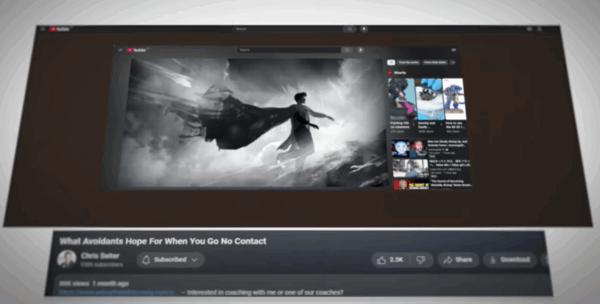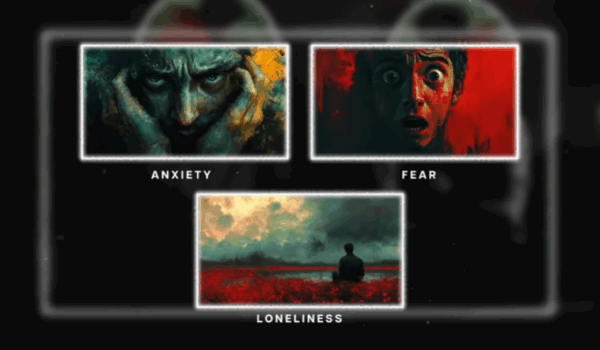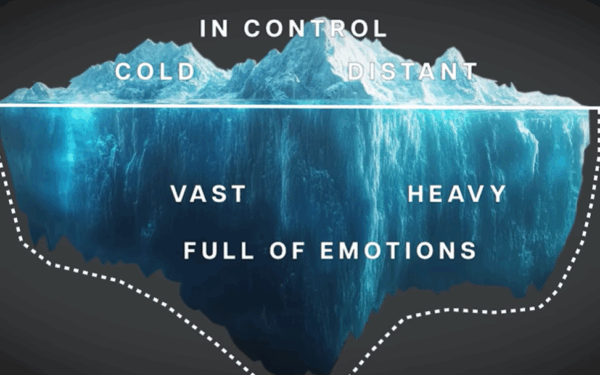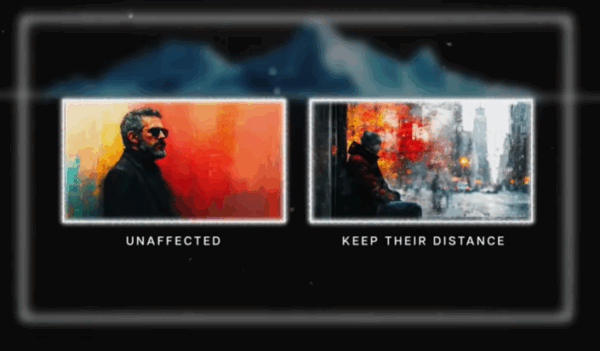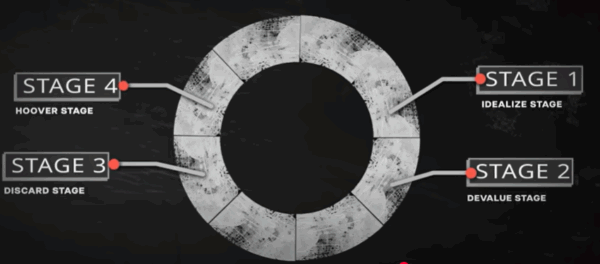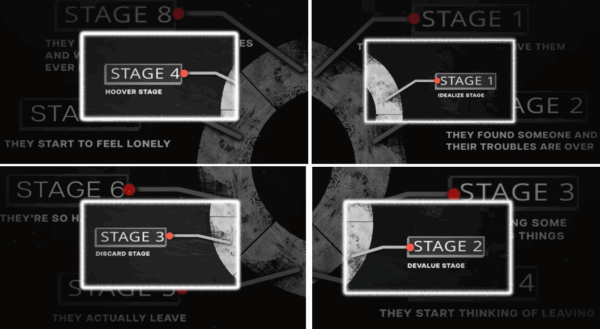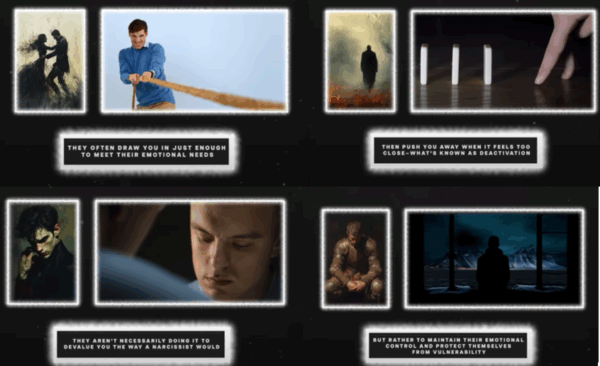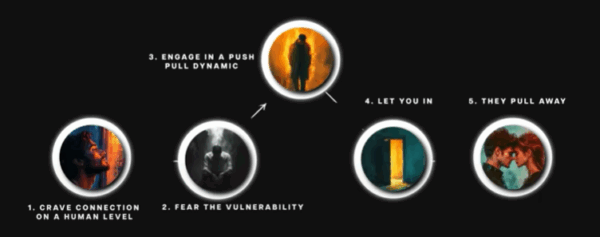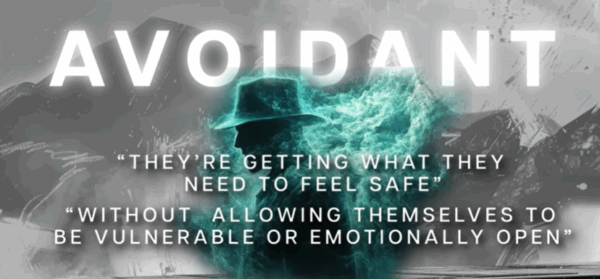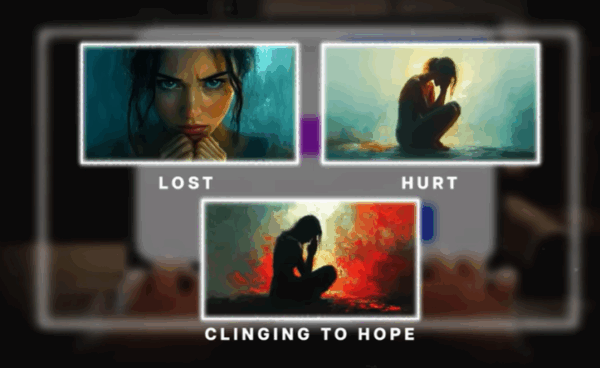Not many people know this, but there are three signs that every avoidant will always show if they’re secretly using you.
And no…
- It’s not ignoring your texts…
- Pulling away…
- Or ghosting…
These are signs you’ve probably never even thought about—but once you see them, you won’t be able to unsee them.
And I’m pretty sure it’ll reframe the way you look at avoidants forever.
Not that you have a “high opinion of them” right now or anything.
Sign #1: Honeymoon Hopping
Ah, the honeymoon period. That magical time in a relationship where everything is perfect, and your partner can do no wrong.
So, one of the best ways that you can tell an avoidant is using you is to see if you are caught in this ungodly honeymoon hopping cycle they tend to put people through.
And let me say, it’s brutal.
Alright, so what is this?
Well, let’s visualize it by pulling up my world famous avoidant death wheel.
Now, on this thing you’ll find that the honeymoon period is located right here, Stage 2: “I found someone my troubles are over.”
If an avoidant had their way, they’d stay in the honeymoon period forever, because it’s the perfect balance for them.
They get the highs of connection, affection, and excitement without the burden of emotional vulnerability or commitment.
Think of it like the ultimate ‘safe zone.’
Ah, but the honeymoon period doesn’t last forever.
Now, you’ll find all kinds of conflicting research on how long the honeymoon period is supposed to last:
- The Cleveland Clinic says, “the honeymoon phase can last for weeks, months or, in some cases, years.”
- “One May 2015 study published in Prevention Science, estimated that the honeymoon phase lasts for about 30 months, or about two-and-a-half years.”
- “In a 2015 study out of New York University, researchers found that the honeymoon phase can last up to 30 months — that’s two and a half years!”
So, the length varies.

What Are Your Chances of Getting Your Ex Boyfriend Back?
Take the quizBut one of the reasons that it might vary for avoidants is that they aren’t going to consider “the honeymoon period” over until they start getting asked the big life question.
Take a look at what happened to this Redditor when at the six month mark she started “to ask the big life questions.. where would we live, would we get married, how did he feel about kids… and I never got a clear answer. I got ‘we’ll figure that out’.. And 3 years later, we hadn’t.”
Let’s take a look at our avoidant death wheel again.
So, we know the honeymoon is here, Stage 2.
Look right below it, Stage 3: “I’m noticing some worrying things.”
More often than not, those worrying things are an avoidants partner wanting a deeper commitment. For the avoidant, this signals that it’s time to jump this sinking ship.
So, they break up with you. Ghost you… Whatever (Stage 5).
Here’s the part no one talks about. There’s a second, hidden honeymoon period.
Look at Stage 6. This is the “I’m so happy that I left” stage.
They relish the peace, the lack of emotional expectations, and the control they’ve reclaimed. It’s like a victory lap.
But here’s the kicker—it doesn’t last nearly as long as the first honeymoon period with a partner.
Why?
Because soon enough, the toll of loneliness sets in (Stage 7).
The freedom that felt so liberating starts to feel hollow. And before they know it, they’re right back where they started—feeling empty, wondering why this always happens to them (Stage 8).
I believe every avoidant lives for these honeymoon periods.
It’s the one thing that keeps them hooked in relationships—not the deeper emotional connection, but the thrill of the honeymoon itself.
And here’s the kicker… they get two in every relationship.
The main one:

What Are Your Chances of Getting Your Ex Boyfriend Back?
Take the quiz- With their partner, where everything is new, exciting, and perfect.
Then, when that inevitably starts to fall apart, they break things off and enter their mini honeymoon—this time with themselves.
- It’s that moment of blissful independence, where they feel free and unburdened by anyone else’s emotional needs.
This constant hopping from relationship to relationship isn’t about finding love or connection. It’s about chasing the high of the honeymoon.
They’re not interested in working through the tough, messy middle of a relationship—they’re addicted to the rush of the beginning and the relief of the end.
So they keep repeating the cycle, never realizing that they’re stuck in this endless loop of temporary highs, always searching for the next honeymoon, but never truly satisfied.
But how does this constitute an avoidant “using you?” I mean that’s what we are here to figure out, right?
That’s why you clicked on this video.
Well, perhaps that’s the greatest irony.
- Avoidants are actually incredibly lonely.
- Beneath all the emotional distance and the walls they put up, they’re craving connection just like everyone else.
- But instead of letting themselves be vulnerable and working through those emotions, they use the honeymoon period in relationships to mask their loneliness.
- For them, the thrill of that honeymoon phase—when everything is perfect and nothing feels too close or too risky—serves as a temporary fix. It’s a band-aid that covers up the deep loneliness they feel but are too scared to confront.
In that sense, they’re using you to fill the emotional void, to chase the high of new love and validation, without ever letting you in fully.
And when the relationship starts to demand more, when real intimacy is required, they cut and run—only to repeat the cycle again with someone else, or in that brief honeymoon period they have with themselves.
And that leads me to my next sign:
Sign #2: The Iceberg Theory
Avoidants are like icebergs—what you see on the surface is just a fraction of what’s really going on beneath.
Here’s the thing: “just because you don’t see them expressing emotions the way you’d expect doesn’t mean they’re not feeling anything.”
- Avoidants often have intense emotions, particularly anxiety, but they’ve learned to suppress them.
As children, they were conditioned to believe that expressing their feelings was either useless or dangerous, so now, as adults, they avoid showing their vulnerability.
Lately on this channel I’ve been talking a lot about this concept of “a magicians cloak.”
- Which is just another fancy word for this “performative facade that avoidants believe they need to put up in order to blend in to society.”
But here’s the truth: the longer they wear this cloak, the more of a burden it becomes. It’s heavy. Constantly having to hide their emotions and project a persona that doesn’t reflect what’s really going on beneath the surface takes a toll.

What Are Your Chances of Getting Your Ex Boyfriend Back?
Take the quizThey’re not just keeping others in the dark—they’re also keeping themselves disconnected from their own feelings.
Over time, that cloak starts to crack.
The weight of unprocessed emotions—anxiety, fear, loneliness—builds up until it becomes impossible to hold everything together.
And those cracks show up in subtle ways: emotional outbursts, sudden withdrawals, or even feelings of deep dissatisfaction with life or relationships.
The facade they’ve been maintaining begins to fall apart. But instead of confronting what’s really happening under the surface, they often double down on their avoidance, retreating even further into that false sense of security, using you—and others—as emotional shields to delay the inevitable reckoning with their own vulnerability.
So, while they might seem cold and detached, that’s just the surface. Underneath, they’re carrying a lot more weight than they let on, and sooner or later, that magician’s cloak they’ve been using to hide will start to fray.
So, let’s play this out.
Before you we have an iceberg in the middle of the ocean:
- At first glance, it looks solid and unshakable.
- You see the tip above the water—cold, distant, and seemingly in control.
- But below the surface, 90% of the iceberg is hidden—vast, heavy, and full of emotions that aren’t visible to the outside world.
Now, imagine this iceberg as an avoidant in a relationship.
- What you see above the water is the calm, detached exterior they present to you.
- They seem unaffected, content to keep their distance. But underneath, there’s a mass of suppressed emotions, anxieties, and vulnerabilities they’re too afraid to show.
Over time, the weight of those hidden emotions starts to cause cracks beneath the surface.
- Little fractures form—maybe an emotional outburst here, or a sudden disappearance there
- Signs that their carefully crafted exterior is starting to crumble.
- But instead of confronting it, they retreat even further, just like an iceberg drifting into colder waters to preserve itself.
And here’s where the ‘using’ part comes in: they use you to help maintain that distance, keeping you at arm’s length to avoid facing what’s beneath. They’ll give just enough to keep you engaged, but they’re always hiding the deeper truth under the surface.
It’s like poking small holes in the iceberg.
- The cracks in the iceberg are like pressure building behind a dam, and instead of letting the whole structure break, avoidants use people like tiny release points.
- They’ll share just enough, or offer small gestures of affection, to let some of that emotional pressure out, keeping you close but never letting the dam burst.
- This way, they prevent a full emotional collapse while still keeping the deeper, more vulnerable parts of themselves hidden behind the wall.
But this entire strategy sounds awfully similar to what narcissists do and that leads me to perhaps my controversial sign:
Sign #3: Set You Up As Supply
When I was researching for this video, I was browsing Reddit and stumbled across this comment in the “anxious attachment subreddit,”
- “…avoidants are narcissists by definition. There entire personality is based around being in complete control, and if you don’t bow to their every whim they will devalue and discard you and pursue the next victim. All avoidants do that same value, devalue/deactivate, discard cycle with their partners.”
Now, while there are definitely things wrong with this comment—like the idea that all avoidants are narcissists (they’re not)—there’s something interesting here worth unpacking.
Specifically, the idea of how avoidants treat their partners in a way that’s similar to how narcissists use people for supply.
I mean, look at the narcissistic abuse cycle:
- Idealize Stage
- Devalue Stage
- Discard Stage
- Hoover Stage
Which if you overlay it on top of the avoidant death wheel, looks an awful lot like what many avoidants are doing:
- You know, the Idealize Stage primarily happening in Stages 1 & 2 of the Avoidant Death Wheel.
- The Devalue Stage happens around Stages 3 & 4
- The Discard Stage happening around Stage 5
- And the Hoover Stage happening with Stages 7 & 8, and the revolution back around to one.
Avoidants may not be driven by ego, in the same way as narcissists, but they do engage in a similar pattern.
- They often draw you in just enough to meet their emotional needs,
- Then push you away when it feels too close—what’s known as “deactivation”.
- They aren’t necessarily doing it to devalue you the way a narcissist would, but rather to maintain their emotional control and protect themselves from vulnerability.
It creates a cycle that can feel a lot like being used, much like how narcissists use others for emotional supply.
Now, what I’m about to say next is my own opinion but take it with a grain of salt. I think avoidants operate similar to narcissists in that they view people as supply.
When we talk about narcissists, we often hear about narcissistic supply—how narcissists feed off admiration, attention, and control to inflate their ego.
But for avoidants, the ‘supply’ they seek isn’t about ego or power. Instead, it’s about emotional distance and control.
Avoidants use people to maintain a sense of emotional safety, much like how narcissists use others to maintain their inflated sense of self-worth.
Here’s how it works:
- Avoidants crave connection on a deep, human level like everyone else
- But they fear the vulnerability that comes with it.
- To keep that fear at bay, they engage in a kind of push-pull dynamic with their partners.
- They’ll let you in just enough to keep the relationship going, to feel the comfort of companionship,
- But then they pull away when things get too close or when you start asking for more emotional investment.
This cycle—where they draw you in and then push you away—gives them a form of supply.
They get to avoid true vulnerability while still reaping the benefits of a relationship, whether that’s physical intimacy, emotional support, or simply the comfort of knowing someone is there for them.
In a sense, they use you to maintain their emotional fortress, to avoid facing the discomfort of intimacy, much like narcissists use others to sustain their fragile sense of self.
And just like with narcissistic supply, when the person they’re using no longer serves their purpose, avoidants often deactivate or discard.
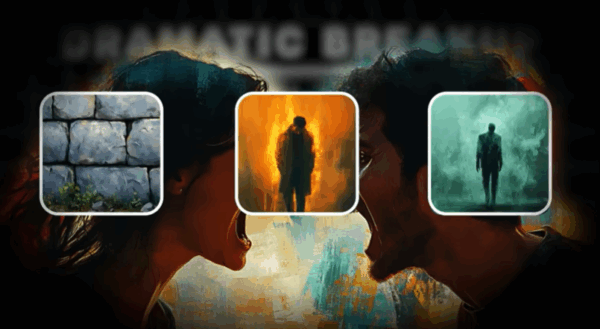
- This doesn’t always mean a dramatic breakup—sometimes it’s emotional stonewalling, withdrawing, or ghosting.
- But the result is the same: they pull away and retreat into their shell, leaving their partner confused, hurt, and searching for answers.
So, while avoidants may not be manipulating people for ego or control the way narcissists do, they’re still using their partners to keep their emotional distance intact.
- “They’re getting what they need to feel safe”—whether that’s love, attention, or even just companionship—”without ever allowing themselves to be fully vulnerable or emotionally open.”
And that’s how they turn people into a kind of supply, much like narcissists do.
Now, make no mistake about it. I’m not saying that being ‘avoidant supply’ is somehow better than being ‘narcissistic supply’.
It’s toxic, no matter how you look at it. Whether you’re dealing with a narcissist or an avoidant, the result is the same—you’re stuck in a cycle where your needs are secondary to their emotional avoidance or control.
It’s important to recognize that if you find yourself trapped in this kind of supply cycle, whether it’s with an avoidant or a narcissist, you need to get out.
- You deserve a relationship where you’re valued for who you are,
- Where your emotional needs are met,
- And where you’re not just being used to fulfill someone else’s need for control or distance.
Staying in these dynamics will only lead to more frustration, confusion, and pain.
Now, that may be a hard thing for you to hear, especially if you came to this channel desperate to rekindle things with an ex who you believe to be avoidant.
But here’s the way I look at it.
Anyone who is searching online to get an ex back is usually doing so from a place of desperation.
- You’re probably feeling lost, hurt, and clinging to the hope that if you just find the right strategy or play the right game, you can make things work.
And I get it—when you’re in that emotional space, it’s hard to think clearly, and all you want is to feel connected again.
But that’s exactly why you need to step out of that desperation before making any big decisions:
- Desperation clouds your judgment.
- It makes you chase after someone, who may not be able to meet your needs, or give you the love you deserve.
- It makes you settle for breadcrumbs, and emotional distance instead of seeking the healthy, fulfilling relationship you’re truly worthy of.
- Take the time to focus on yourself—your healing, your boundaries, your self-worth.
- When you’re no longer operating from a place of fear and need, you’ll see the situation with much clearer eyes.
- Only then, can you make a real decision about, whether to pursue that person, or to move forward in a healthier direction.
Trust me, stepping out of desperation gives you the power to choose what’s truly right for you.

